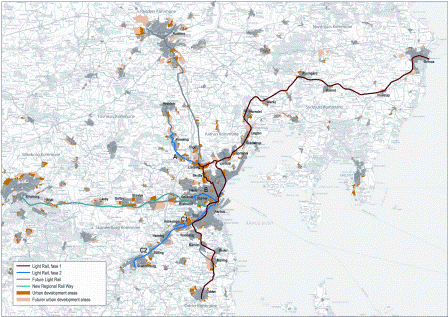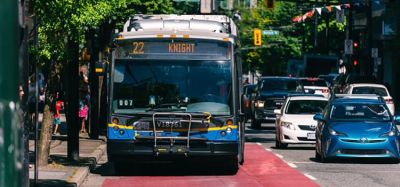Act brings Denmark’s first lightrail a step closer
- Like
- Digg
- Del
- Tumblr
- VKontakte
- Buffer
- Love This
- Odnoklassniki
- Meneame
- Blogger
- Amazon
- Yahoo Mail
- Gmail
- AOL
- Newsvine
- HackerNews
- Evernote
- MySpace
- Mail.ru
- Viadeo
- Line
- Comments
- Yummly
- SMS
- Viber
- Telegram
- Subscribe
- Skype
- Facebook Messenger
- Kakao
- LiveJournal
- Yammer
- Edgar
- Fintel
- Mix
- Instapaper
- Copy Link
Posted: 25 June 2012 | Ole Sørensen, Head of the Light Rail Secretariat and Project Manager, Midttrafik | No comments yet
Construction of the initial phase of Denmark’s first light-rail network has now progressed from the planning to the construction phase, as the Danish Government recently passed the Aarhus Light Rail Act. Work towards the building of a light-rail network in the Aarhus area began in 2007 when eight local authorities, the Central Denmark Region, and the regional public transport authority, Midttrafik, entered a formal partnership to develop a light-rail transit network (LRT network) centred around Denmark’s second largest city, Aarhus.
The procurement strategy for Phase 1 of the LRT network will soon be presented. It is expected that prequalification and tender will take place during summer and autumn 2012. At the same time, the parties involved in the Aarhus Light Rail Partnership are planning to extend the network with more light-rail lines in Aarhus and to neighbouring towns in the Aarhus region. The State is also considering a possible new and fast regional railway line between Silkeborg and Aarhus.
The vision to build a light-rail transit network around Aarhus is now closer to becoming a reality as the Danish Government has adopted the Aarhus Light Rail Act of 8 May 2012.
Construction of the initial phase of Denmark’s first light-rail network has now progressed from the planning to the construction phase, as the Danish Government recently passed the Aarhus Light Rail Act. Work towards the building of a light-rail network in the Aarhus area began in 2007 when eight local authorities, the Central Denmark Region, and the regional public transport authority, Midttrafik, entered a formal partnership to develop a light-rail transit network (LRT network) centred around Denmark’s second largest city, Aarhus. The procurement strategy for Phase 1 of the LRT network will soon be presented. It is expected that prequalification and tender will take place during summer and autumn 2012. At the same time, the parties involved in the Aarhus Light Rail Partnership are planning to extend the network with more light-rail lines in Aarhus and to neighbouring towns in the Aarhus region. The State is also considering a possible new and fast regional railway line between Silkeborg and Aarhus. The vision to build a light-rail transit network around Aarhus is now closer to becoming a reality as the Danish Government has adopted the Aarhus Light Rail Act of 8 May 2012.
Construction of the initial phase of Denmark’s first light-rail network has now progressed from the planning to the construction phase, as the Danish Government recently passed the Aarhus Light Rail Act. Work towards the building of a light-rail network in the Aarhus area began in 2007 when eight local authorities, the Central Denmark Region, and the regional public transport authority, Midttrafik, entered a formal partnership to develop a light-rail transit network (LRT network) centred around Denmark’s second largest city, Aarhus.
The procurement strategy for Phase 1 of the LRT network will soon be presented. It is expected that prequalification and tender will take place during summer and autumn 2012. At the same time, the parties involved in the Aarhus Light Rail Partnership are planning to extend the network with more light-rail lines in Aarhus and to neighbouring towns in the Aarhus region. The State is also considering a possible new and fast regional railway line between Silkeborg and Aarhus.
The vision to build a light-rail transit network around Aarhus is now closer to becoming a reality as the Danish Government has adopted the Aarhus Light Rail Act of 8 May 2012.
The Act is the legal basis on which the first modern light-rail network in Denmark will be built. Other light-rail projects planned in Copenhagen, Odense and Aalborg are expected to use the Aarhus Light Rail Act as a model.
The Aarhus Light Rail Act is a combined construction and company Act. The Act forms the legal basis for construction of Phase 1 of the LRT network and for the establishment of a general partnership company called Aarhus Light Rail. The partners in the project own the company. They are the municipality of Aarhus, which has a 47.2% share in the company, Denmark’s Minister for Transport – and thus the State of Denmark – which has a 47% share of the company, and Central Denmark Region, which owns 5.8% of the company. The three parties entered a political agreement to fund Phase 1 of the LRT network in autumn 2011. The adoption of the Aarhus Light Rail Act ratifies the political agreement.
The State of Denmark will play a significant part in the construction phase but will withdraw from the project as soon as the light-rail goes into operation. The Act foresees that, when the time comes, the local partners, i.e. the municipality of Aarhus and Central Denmark Region, will set up an operating and infra – structure company, which will be responsible for running the Aarhus Light Rail network. Light-rail operations will be put out to EU public procurement tender.
In the Central Denmark Region, the regional public transport authority, Midttrafik, is responsible for timetable planning, the route network and connections to and from the different public transport systems. This task will remain in Midttrafik’s hands and the LRT network will be integrated into the public transport system on an equal footing with other public transport services.
Midttrafik’s role in the running of the LRT network also explains why the transport authority is the only organisation outside the ownership group to occupy a seat on the Board of Aarhus Light Rail. The remaining Board members are nominated by the Minister for Transport (one Board Member), Central Denmark Region (one Board Member) and the municipality of Aarhus (two Board Members, one of whom, in pursuance of the Act, becomes Chairman of the Board).
Diesel-electric hybrid or electric light-rail trains?
One of the first tasks facing the company is to put the construction work out to tender. Prequalification and the subsequent public procurement tender are expected to take place during summer and autumn 2012.
Phase 1 of the LRT network will connect two existing local lines – the Grenaa Railway and Odder Railway, which are 69km and 26.5km-long, respectively. Today, the regional trains on these lines run on diesel. Both lines will be converted to light-rail operations and connected via a new, 12km, electrified light-rail line.
The assumptions in the environmental impact assessment prepared in the period 2008-2010 were that diesel-electric hybrid trains would be purchased and that they would operate as diesel-powered trains on the existing local lines, but as electric trains on the new line and in central areas of Aarhus.
Trains of this kind are currently operating in Kassel, Germany. In 2007, when work on the LRT network began, it was anticipated that dieselelectric hybrid LRT trains would be an attractive alternative to cost-intensive electrification of the long local lines, where traffic is relatively light.
However, the market for diesel-electric LRT trains has not developed as expected. Two public procurement tenders comprising diesel-electric hybrid trains have been cancelled within the past year (tenders for Chemnitz and Braunschweig) and there is currently not a single diesel-electric hybrid train in operation in Europe that could easily be supplied to the Aarhus Light Rail project. The Regio Citadis train in Kassel will also have to be redesigned to meet new EU standards.
New calculations prepared in connection with the procurement strategy also indicate that it is highly probable that the most economically advantageous solution would be to extend electrification to include the Odder Railway and part (and possibly all) of the Grenaa Railway. To encourage as much competition as possible, further electrification will be an open option in the procurement strategy and the results of tender will be decisive for the extent to which the lines in Phase 1 will be electrified.
Plans for more light-rail lines and a local line to Silkeborg
Phase 1 of the LRT network is intended to be the first of several lines, which will bring more lightrail lines to Denmark’s second largest urban development area. Since 2007, a light-rail partnership between eight local authorities in the area, Central Denmark Region and the regional public transport authority, Midttrafik, has been formally committed to planning the construction of a LRT network in Eastern Jutland. The vision is to build an efficient public transport network that will provide good, direct connections to major destinations, not only for urban traffic in Aarhus city, but also for commuter traffic to and from the neighbouring municipalities. The LRT network will comprise an extension of the network with more lines and a network of bus lines to supplement and feed the light-rail.
Parallel with the planning of Phase 1, the financial consequences of expanding the LRT network in the Aarhus region have been investigated. In autumn 2011, the parties of the Light Rail Partnership presented a survey investigating four potential line extension options – including two lines to the neigh – bouring municipalities of Skanderborg and Favrskov, and two lines in Aarhus itself.
The survey is detailed enough to meet, among others, the Danish Ministry for Transport’s socioeconomic calculation require ments, which means that it can be considered the final preparatory level of investigation before an environmental impact assessment can be initiated. The survey will therefore be included in local and State prioritisation of the next phases of the Light Rail development.
As the map of Figure 2 (below) shows, the Light Rail Partnership plans to extend the LRT network with more lines to neighbouring municipalities and more lines in Aarhus. Furthermore, the Danish State is also considering a possible new and fast regional railway connection between Silkeborg and Aarhus.


Figure 2: The vision for a Light Rail Transit network (LRT network) to include (in addition to Phase 1) lines extending to several neighbouring municipalities around Aarhus and a new regional line to Silkeborg
Road traffic congestion
The local authorities’ interest in introducing a LRT network to help improve public transport is motivated on the one hand by a desire to build an efficient and more eco-friendly transportation system, and on the other hand to counteract road traffic congestion and further strengthen opportunities for development in Eastern Jutland.
In 2010, the population of the Aarhus region was just over 690,000, of which 300,000 lived in Aarhus. In 2040, the population of the Aarhus region is expected to grow to just over 800,000, of which 360,000 will be living in the city itself. Growth in the region will bring consistently greater pressure on the road system. Every day, approximately 60,000 people commute to and from a workplace in Aarhus. The main roads into Aarhus are already congested. An extensive and efficient public transport system will help alleviate road traffic congestion and thus also pave the way for continuing growth in the Aarhus region.
Urban development along the LRT system
If you are going to successfully attract passengers to public transport systems in urban areas, you have to make sure that travelling times are faster than when travelling by car. This requires that the backbone of the public transport system features lines with highfrequency services, priority operation and ease of access, which is essentially what the Light Rail project is intended to achieve. At the same time, clusters of urban development in the Aarhus region will form along the axes carrying the efficient public transport system, combined with short distances between urban functions and stops.
The local authorities in the Light Rail Partnership have made a series of wide-ranging amendments to their latest municipal plans to facilitate urban development plans which better underpin the extension of the prospec – tive LRT system.
More Danish light-rail networks in the pipeline
When the Aarhus light-rail network is up and running, it will be the first of its kind in Denmark, but there are already several more light-rail projects in the pipeline. Light-rail is being considered a feasible option in and around the major cities as new infrastructures and urban development are planned.
In Copenhagen, the Minister for Transport, Capital Region of Denmark and 11 neighbouring local authorities have agreed to build a light-rail line along the Ring 3 motorway from Lundtofte in the north, to Ishøj in the south.
In Odense, a light-rail network is included in an overarching strategy to promote the growth, attractiveness and transformation of the city, entitled ‘Odense – transforming a large Danish town into a major Danish city’. Odense City Council has completed preliminary light-rail surveys and expects to have completed the consultancy tender before the summer.
In Aalborg, the regional transport authority, Nordjyllands Trafikselskab, will soon be taking steps to prepare a preliminary survey for the first phase of a light-rail network. The first line will run in the so-called University Corridor between Aalborg Bus Terminal in the city centre and the future Aalborg university hospital, via the university in the east of the city.
About the author
Ole Sørensen has an MSc in geography. Ole has been working with planning of public transport in Aarhus, Denmark, for 13 years. Previously, Ole was Manager of the Planning Department of Midttrafik, which is the PTA covering the Cental Denmark Region. In connection with the Light Rail Transit (LRT) plans, he is now Head of the Light Rail Secretariat and Project Manager for the work dealing with a new public transport plan for the City of Aarhus. The Light Rail Secretariat was established in 2008 by the City of Aarhus, eight surrounding municipalities and the Central Denmark Region.
Related topics
Business Models, Fleet Management & Maintenance, Infrastructure & Urban Planning, Multimodality, Ticketing & Payments, Transport Governance & Policy
Issue
Issue 3 2012
Related cities
Denmark
Related organisations
Aarhus light-rail project, Midttrafik
Related people
Ole Sørensen








